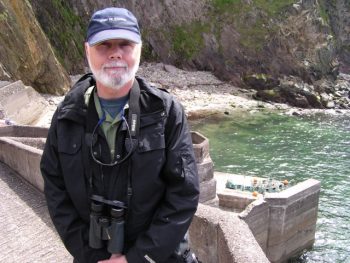Q&A with Dr. Tom Leschine
How did you decide to become a professor?
Sometimes you have to take a leap to get what you really want. I was on a narrow path, teaching math in a two-year college while working on my Ph.D., when a terrific opportunity presented itself—a post-doctoral fellowship in marine policy at the Woods Hole Oceanographic Institution. Although I very much enjoyed the teaching I was doing, I came to realize that teaching alone was not enough, I also wanted to remain an active researcher. At Woods Hole I found my path to the career I was looking for, I just didn’t know yet where that path would lead. Eventually it led me to UW’s Institute for Marine Studies, forerunner to SMEA, where I’ve been ever since.
What do you like most about your work?
No question about it, working with students has been the most gratifying part of the job, especially mentoring students as they develop their research directions. Some of my most rewarding experiences have been with student RAs working with multidisciplinary research teams where there are “many fingers in every pot”. Students learn not just from me but from other project participants, be they students from other departments or universities, or the diverse researchers and others who also become engaged through project work. Students bring what they’ve learned back to me so in a sense we learn together. It’s great to see those students graciously extending their thanks, once their own thesis or dissertation work is complete, to whole networks of people they didn’t even know when they started. Among the more joyous occasions in life is graduation, and it’s great to have been able to be there year after year to share that special day with students, to see the pride they feel in all that they’ve accomplished, whatever their path through SMEA has been.
If you could have any amount of funding to conduct research, what would you do, and why?
Over the past few years I’ve become increasingly preoccupied with the environmental and human impacts of climate change, especially as they are now unfolding in the Arctic. Ironically, the Arctic Ocean is now being referred to as the “final frontier” for oil and gas, whose continuing consumption puts them among the leading contributors to climate change and through it, the collapse of Arctic ecosystems. The Arctic is far away, vast, and daunting, but I can envision the circumpolar trip I’d take if I had the funds, visiting the nations that surround the Arctic Ocean and spending time above the Arctic Circle, learning the issues from the perspectives of all involved—be they policy makers, aspiring industrialists, citizens and officials in northern communities, or especially, the indigenous peoples of the Arctic who have the most at stake as permafrost thaws and sea ice melts away. I had the opportunity to spend Spring 2015 in Norway, and while there I read a book whose author took a research trip something like my dream trip. He did a great job of defining the trajectories the Arctic nations and their peoples are currently on in a world of rapid change, but what can be done to bend those trajectories toward enhanced sustainability?
How would you describe SMEA students?
Energetic, enthusiastic, passionate about the oceans and ocean life, and at SMEA because they too want to become agents of change. The great diversity of student experience featured in our class cohorts year after year has proven a catalyst for learning. In every class a synthesis of sorts occurs, making the whole greater than the sum of its parts, the individual students. Inevitably I come to see and appreciate how students learn from each other, augmenting considerably what they get from us in the classroom. They’re making friends and colleagues they’ll have for life.
What advice would you give to students who are considering studying at SMEA?
Keep the end in mind as you think about graduate school, but avoid becoming slave to your own ideas about what you’d do once you’re here and post-graduation. If I’d done that I’d still be teaching math. The field of marine affairs is constantly evolving, in response to changing perceptions of marine environmental problems and opportunities as well as ever-changing faculty and student interest. Students challenge us more than ever—what we teach and how we teach it, the very nature of what it means to be in a mentor-student relationship. Universities are changing as a result; at UW there is now growing engagement in interdisciplinary and cross- and trans-disciplinary studies in all their forms. That’s one of the best reasons to come to SMEA and UW, what you can learn elsewhere on campus or through the field work you do, the mind-expanding effect it will have on you.
What is your favorite form of marine life, and why?
A sociologist former colleague and I shared the experience of sitting on many a National Research Council committee otherwise dominated by geologists, chemists, engineers and other “hard science” practitioners. He liked to say—in response to the lecture he would occasionally get from someone fixated on the centrality of the hard sciences to the committee’s work—that, “No, I’m the one who does ‘hard’ science, I study people!” People are the central actors where the fate of the oceans is concerned, and if “Free Willy” is some kind of symbol of freedom achieved through perseverance and manta rays the epitome of grace in motion, that’s only because they’ve come to represent those things in our eyes. Their fate is literally in our hands, and we need to keep people—as individuals, communities, and societies—and for all that they do that is consequential for the oceans and ocean life, at the center of the marine affairs equation. That we do that is a big reason why SMEA continues to thrive in a world otherwise dominated by the STEM disciplines.
